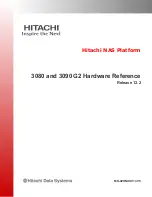
Rev. 2.00, 09/03, page 136 of 690
6.4
Interrupt Sources
There are five types of interrupt sources: NMI, IRQ, IRL, PINT, and on-chip peripheral modules.
Each interrupt has a priority level (0 to 16), with 1 the lowest and 16 the highest. Priority level 0
masks an interrupt, so the interrupt request is ignored.
6.4.1
NMI Interrupt
The NMI interrupt has the highest priority level of 16. When the BLMSK bit in the interrupt
control register 1 (ICR1) is 1 or the BL bit in the status register (SR) is 0, NMI interrupt is
accepted. NMI interrupt is edge-detected. In sleep or standby mode, the interrupt is accepted
regardless of the BL setting. The NMI edge select bit (NMIE) in the interrupt control register 0
(ICR0) is used to select either rising or falling edge detection.
When using edge-input detection for NMI interrupt, a pulse width of at least two P
φ
cycles
(peripheral clock) is necessary. NMI interrupt exception handling does not affect the interrupt
mask level bits (I3 to I0) in the status register (SR). When the MAI bit in ICR1 is 1, NMI interrupt
is not accepted.
It is possible to wake the chip up from sleep mode or standby mode with an NMI interrupt.
6.4.2
IRQ Interrupts
IRQ interrupts are input by level or edge from pins IRQ0 to IRQ5. The priority level can be set by
interrupt priority registers C and D (IPRC and IPRD) in a range from 0 to 15.
When using edge-sensing for IRQ interrupts, clear the interrupt source by having software read 1
from the corresponding bit in IRR0, then write 0 to the bit.
When ICR1 is rewritten, IRQ interrupts may be mistakenly detected, depending on the IRQ pin
states. To prevent this, rewrite the register while interrupts are masked, then release the mask after
clearing the illegal interrupt by writing 0 to interrupt request register 0 (IRR0).
Edge input interrupt detection requires input of a pulse width of more than two cycles on a P clock
basis.
When using level-sensing for IRQ interrupts, the pin levels must be retained until the CPU
samples the pins. Therefore, the interrupt source must be cleared by the interrupt handler.
The interrupt mask bits (I3 to I0) in the status register (SR) are not affected by IRQ interrupt
handling. IRQ interrupts can wake the chip up from the standby state when the relevant interrupt
level is higher than I3 to I0 in SR (but only when the RTC is used, the clock for the RTC is used to
wake the chip up from the standby state).
Содержание SH7705
Страница 2: ......
Страница 46: ...Rev 2 00 09 03 page xlvi of xlvi Appendix Table A 1 I O Port States in Each Processing State 679 ...
Страница 70: ...Rev 2 00 09 03 page 24 of 690 ...
Страница 194: ...Rev 2 00 09 03 page 148 of 690 ...
Страница 284: ...Rev 2 00 09 03 page 238 of 690 ...
Страница 338: ...Rev 2 00 09 03 page 292 of 690 ...
Страница 354: ...Rev 2 00 09 03 page 308 of 690 ...
Страница 374: ...Rev 2 00 09 03 page 328 of 690 ...
Страница 420: ...Rev 2 00 09 03 page 374 of 690 ...
Страница 476: ...Rev 2 00 09 03 page 430 of 690 ...
Страница 482: ...Rev 2 00 09 03 page 436 of 690 ...
Страница 552: ...Rev 2 00 09 03 page 506 of 690 ...
Страница 630: ...Rev 2 00 09 03 page 584 of 690 ...
Страница 739: ...SH7705 Group Hardware Manual REJ09B0082 0200O ...
















































